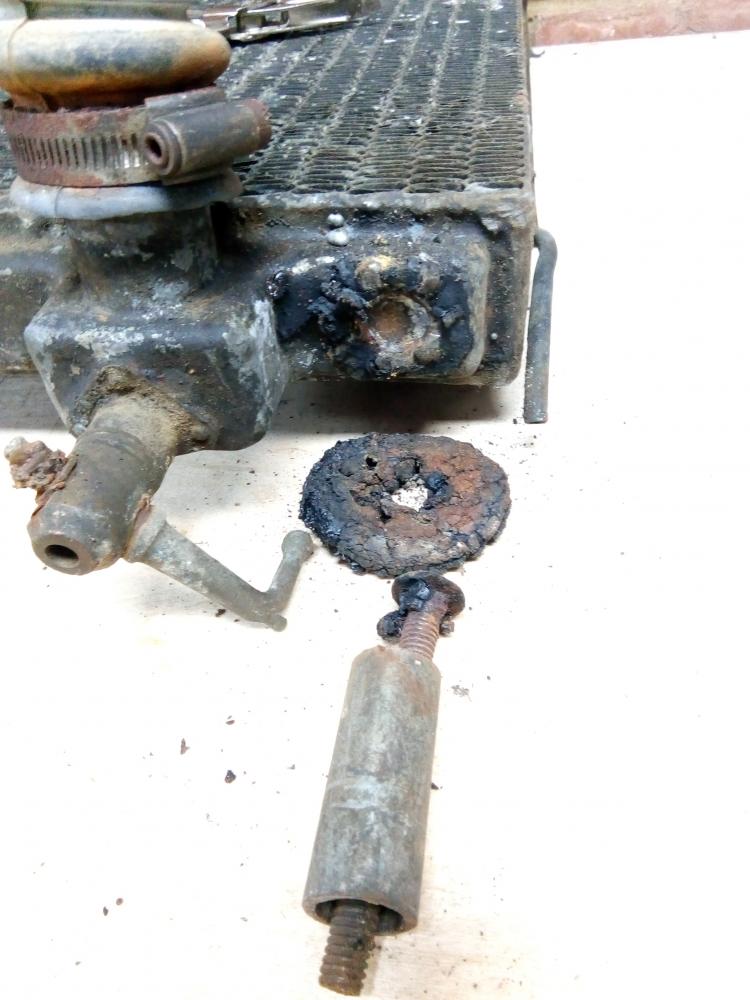Joined: Aug 2017 Posts: 1,920 Threads: 90
Reputation:
17
Location: Ripon
14-10-2018, 12:32 AM
(This post was last modified: 14-10-2018, 12:36 AM by Duncan Grimmond.)
I think that the bolts you show may be spurious. In my limited knowledge of the supports the ones I am familiar with are folded metal supports bolted to the radiator shell with a vibration absorbing pad on which the radiator sits. Have a look at the cherished suppliers catalogues for reference.
Ruairidh will have better photos than I can find!
Depending on the state of the damage you may be able to salvage the radiator with a soft soldered patch. If not, a replacement will be necessary.
Joined: Aug 2017 Posts: 2,748 Threads: 31
Reputation:
95
Location: Auckland, NZ
14-10-2018, 04:47 AM
(This post was last modified: 14-10-2018, 04:49 AM by Bob Culver.)
A soldered patch of brass or copper would seem very straightforward. I presume traditional solder is still readily available.
I gather radiator solder has/had more tin than 50/50 but would suffice in that application Clean copper and brass tin very well.
It is mutiple tube leaks and leaks within the core that often spell doom.
Joined: Aug 2017 Posts: 772 Threads: 26
Reputation:
8
Location: On a hill in Wiltshire
A quick fix to check for leaks is to bung up holes with Plasticene.
Then you can fill with water, rust eater or whatever, without wasting time soldering if the rest of it is no good.
Simon
Joined: Aug 2017 Posts: 522 Threads: 17
Reputation:
10
Location: Hampshire UK
Hello PhilM
I believe the original radiator fixing was by two threaded studs soldered into the bottom tank. These passed through the mounting brackets in the chassis, via square felt pads to protect the tank from chafing. Each stud had a coil spring, washer and nut with split pin to give resilient mounting. Access is from underneath and is not the easiest. There is a not very detailed drawing on page 76 of the Austin Seven companion.
I have successfully repaired these studs in the past by making a pad of brass about an inch square and an eigthth of an inch thick. Drill a hole into the centre and tap it to take brass studding, which can be screwed in and then soldered (the solder will "wick" into the thread). The resulting "mushroom" can then be soldered to the bottom tank, but in my case I fought shy of the heat needed and used "JB weld" metal loaded epoxy instead. To help the bond, everything must be bright clean and roughened with coarse sandpaper. I also put a series of small holes in the plates for the epoxy to flow into and grip. When reassembling I used nyloc nuts, as split pins are too fiddly.
As noted above, it might be worth checking for any other leaks first, before putting in too much work.
Joined: Aug 2018 Posts: 188 Threads: 5
Reputation:
0
Location: Dorset seaside
14-10-2018, 10:35 AM
(This post was last modified: 14-10-2018, 10:36 AM by Nigel Ricardo.)
I had a stud missing on the Pearl I am doing at the moment, I used Gorilla Glue to stick a hex head BSF bolt to the bottom tank and then used an engine mounting with central hole enlarged between the radiator and mounting bracket.
Joined: Feb 2018 Posts: 38 Threads: 11
Reputation:
0
Location: Canterbury, Kent
Car type: 1936 Two Seater (Opal?)
14-10-2018, 10:37 AM
(This post was last modified: 14-10-2018, 10:40 AM by PhilM.)
Many thanks for your helpful replies.
Duncan, perhaps I should have said in my original post that the original mounts are still there on the body albeit a bit crusty and distorted.
I'm having difficulty adding pictures at the moment otherwise I would have included a picture of the body mounts. It seems rather hit and miss adding attachments, perhaps I'm doing something wrong, would somebody tell me the correct procedure please.
John, many thanks for the detailed description of the original setup, at least I now know roughly what I'm trying to achieve, if anybody had a picture however that would be great,
All replies are much appreciated, I think I will enlist the help of a professional I don't trust myself not to end up with a sieve.
I am aware of a couple of radiator "specialists" in the area but if anybody knows of a reliable one in or around Kent please let me know.
..... Phil.
Hmm... JB Weld and Gorilla glue, are they really up to the job??? do they stand up to the heat and vibration???
Thanks, ..... Phil.
Joined: Aug 2017 Posts: 3,209 Threads: 100
Reputation:
26
Location: Darkest Bedfordshire
14-10-2018, 11:24 AM
(This post was last modified: 14-10-2018, 11:28 AM by Chris KC.)
Open a new reply pane; then select your attachment using 'browse' at bottom left.
Then press 'add attachment' at bottom right.
This will add it to a list at bottom of page, but you still need to press 'insert into post' to show it in the reply pane.
It will insert wherever you last left the cursor...
It will appear as a link not a picture, press 'preview post' to see the finished result.
I'll PM you with a suggestion
Joined: Feb 2018 Posts: 38 Threads: 11
Reputation:
0
Location: Canterbury, Kent
Car type: 1936 Two Seater (Opal?)
Thanks Chris, that's pretty much what I've been doing but more than 50% of the time a blank page appears when I click "add attachment" and the file is not added to the list when I close that blank page???
.... Phil







